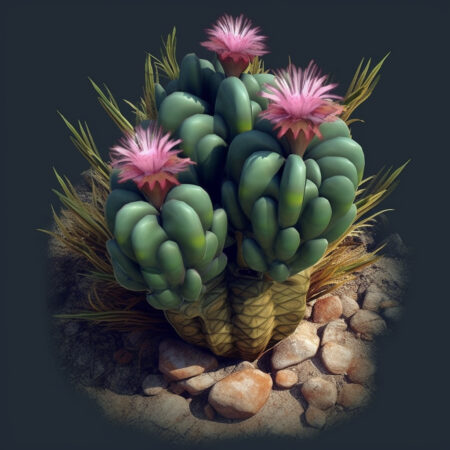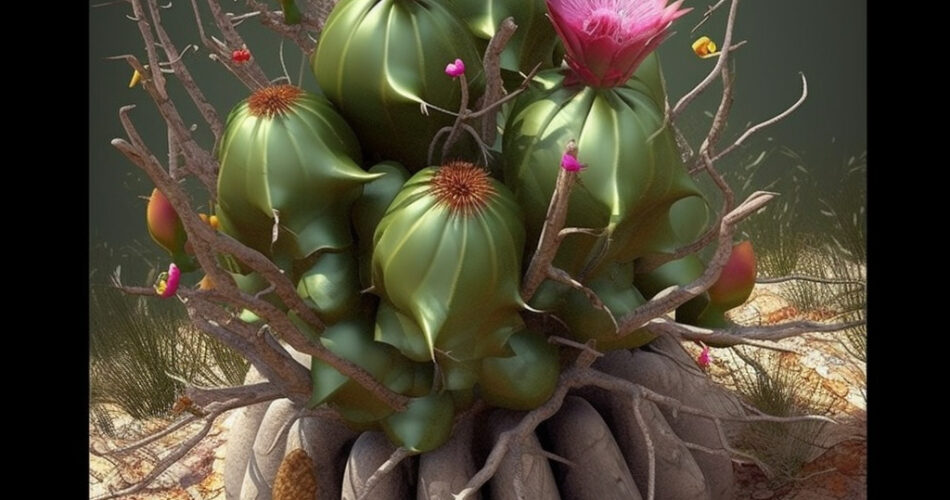Key Takeaways:
- This unique genus from the Cactaceae family predominantly graces the landscapes of the Southwestern U.S. and Mexico.
- Known for methodical growth patterns, they often achieve distinctive spherical or columnar forms.
- A combination of flavonoids in their blooms and bristles, as well as chlorophyll, contributes to their varied colorations, with environmental factors playing a significant role.
- Adapted for desert climates, they boast protective spikes and a compact shape. Their photosynthesis approach, known as CAM, also stands out.
- These plants flourish in elevations between 1000-2000 meters and are equipped with a comprehensive root system, earning admiration from horticultural enthusiasts worldwide.
- With the globe warming and rainfall patterns changing, the distribution of this genus is under threat.
- In times gone by, indigenous tribes have looked to these cacti for medicinal, spiritual, and nutritional value.
- Over the years, their resilience and form have become symbols in various artistic renditions.
- Modern challenges like habitat disruption, unauthorized extraction, and global ecological shifts threaten their existence.
- Efforts to conserve them include preserving their natural habitats, curbing illegal trade, endorsing sustainable farming, and banking seeds for future propagation.
- Promotion of ethical growing practices and making informed purchasing decisions can play a pivotal role in securing their future.
For the keen nature enthusiasts and plant aficionados, delving into the realm of the Echinomastus genus affords a fascinating journey. Emerging from the cactus family – Cactaceae, this botanical magnificence presents thrilling biological functions, fascinating geographical spread, significant impacts on human culture, and critical environmental implications. This article aims to be your comprehensive guide, unravelling this myriad world of Echinomastus plants, beckoning you to explore more.
Discovering the Rich Biology of Echinomastus
Decoding Unique Growth Strategies
The southwestern landscapes of the United States and parts of Mexico are home to Echinomastus, a captivating genus of cacti known for its distinct stature. Characterized by globular and cylindrical shapes, this genus showcases robust spines paired with alluring, tubular blossoms. These plants are a testament to the resilient nature of desert flora, demonstrating adaptability to environments regularly plagued with scarce resources.
– **Growth Genesis**: Starting from humble seed beginnings, these cacti evolve into mature plants with a methodical pace akin to many desert dwellers.
– **Radial Enlargement**: This process allows the plant to grow uniformly in all directions, giving it a balanced appearance.
– **Elongation Strategy**: This focuses on increasing the plant’s height, ultimately leading to the formation of the notable spherical or cylindrical silhouettes.
The Art of Nature’s Color Palette
Always a subject of admiration, these cacti exhibit a vibrant range of colors in their bristles, fruits, and blossoms. The myriad of shades isn’t just for show; they have a functional purpose intertwined with the plant’s biology.
– **Floral Hues**: Generally found in shades of white, pink, or yellow, the flowers derive their color from flavonoid pigments.
– **Bristle Tints**: Their bristles shine in varying tones, ranging from translucent white to misty grey, occasionally adorned with contrasting tips.
– **The Green Spectrum**: Rooted in the presence of chlorophyll, this pigment is fundamental for photosynthesis. The surrounding environment, including soil and climate, further accentuates these natural shades.
Mastering the Art of Desert Survival
Resilience defines the essence of these desert gems. Their ingenious survival tactics are nothing short of evolutionary marvels, allowing them to flourish in hostile terrains.
– **Defensive Armor**: A spiky exterior wards off potential threats, safeguarding the precious water reservoirs within.
– **Smart Design**: Their form, whether it’s round or elongated, minimizes water evaporation – a crucial adaptation in water-starved habitats.
– **Photosynthesis with a Twist**: Employing a specialized method known as CAM, these plants adapt their respiratory cycle, conserving water by keeping stomata closed during scorching days and opening them during the cooler nights.

Adapting to Diverse Landscapes: The Echinomastus Journey
Endearing Bonds with Harsh Terrains
While they may appear formidable, Echinomastus species share an unyielding relationship with parched landscapes, notably thriving in regions like the Southwestern United States and parts of Mexico. These cacti are adept at navigating the challenges of environments that boast vast elevation ranges, temperature extremes, and minimal precipitation.
Key to their survival:
– **Water Mastery**: Their structural design is optimized to capture and conserve water during rare rainfalls.
– **Root Architecture**: A specialized root system spreads out, efficiently drawing nutrients from the nutrient-rich, rocky desert substrate.
Branching Out: A Global Footprint Beyond Native Lands
Looking beyond their native terrain, the appeal and allure of Echinomastus have transcended borders, winning the hearts of plant enthusiasts worldwide. Recognized for both their tenacity and aesthetic appeal, these cacti have been integrated into diverse ecosystems, from curated gardens in Europe to nurseries in the Australian outback.
Globally admired:
– **Resilience and Beauty**: This captivating combination has earned them a cherished spot in international horticultural collections.
– **Diverse Habitats**: Embraced by gardeners and conservators, they’ve found homes in a variety of climates and settings.
Understanding the Climate Paradigm: Shifts and Survival
The ongoing global climate transition presents daunting challenges for many plants, including the robust Echinomastus. Altered precipitation patterns and rising temperatures exert pressures on their traditional growth and reproduction rhythms. While certain populations exhibit signs of strain, the inherent adaptability of these cacti provides a silver lining.
Challenges and Adaptations:
– **Distribution Disruptions**: Variations in weather patterns have led to alterations in their natural habitats, influencing their global spread.
– **Resilient Species**: Despite adversities, numerous Echinomastus species endure, symbolizing the adaptability of desert flora in the face of climate shifts.
The Cultural Tapestry of Echinomastus: Intersections with Humanity
Medicinal Marvels and Myths
Delving into the pages of history, Echinomastus emerges not just as a plant, but as a significant cultural symbol. From spiritual ceremonies to medicinal concoctions, its use was varied and valued. Ancient tribes integrated the cacti into their customs, leveraging them in rituals believed to bestow fertility. On the health front, their roots were often brewed into tonics to alleviate respiratory issues, while the cooked cactus was considered beneficial for metabolic challenges.
Key Aspects:
– **Spiritual Significance**: Their role in rituals signified the profound respect tribes held for the natural world.
– **Therapeutic Traits**: Boiled or infused, Echinomastus found its way into traditional remedies, exemplifying nature’s pharmacy.
Nourishment and Narrative: The Tribal Ties
The intricate weave between indigenous communities and Echinomastus is a testament to the latter’s multifaceted significance. Beyond healing, these cacti offered sustenance. Tribes ingeniously utilized the cacti’s bounty, transforming flowers, seeds, and fruits into palatable meals or even milling the pulp into flour.
Reflections:
– **Sustenance Source**: As a dietary supplement, Echinomastus offered an alternative to conventional farming, especially in challenging terrains.
– **Cultural Canvas**: The cactus also etched its mark on tribal artistry, adorning their tales, art, and spiritual narratives.
Artistic Allure: The Echinomastus Essence
The distinct geometry and resilience of Echinomastus have long enchanted the artistic realm. Legendary artists like Paul Klee and Georgia O’Keeffe captured its essence, translating it onto canvas, each brushstroke revealing the plant’s allure. The literary domain too wasn’t immune to its charm. Writers often drew parallels between the cacti’s hardiness and human perseverance, casting it as a symbol of unyielding spirit in their narratives.
Artistic Inspirations:
– **Visual Vernacular**: Paintings and sculptures have encapsulated the plant’s visual appeal, making it a perennial favorite in botanical art.
– **Literary Luminary**: As a metaphor or symbol, Echinomastus resonates with the themes of endurance and resilience, inspiring poetic and prose expressions alike.
Charting the Future of Echinomastus: A Dance of Conservation and Community
Challenges at Horizon: Echinomastus and Environmental Perils
While Echinomastus might seem invincible with their hardy exteriors, they are far from impervious to current environmental challenges. With the thermometer inching higher, coupled with more pronounced droughts and vanishing habitats, these cacti find themselves at the crossroads. Illegal extractions, driven by burgeoning demands from collectors and ornamental enthusiasts, exacerbate their precarious position.
Guardians of the Green: Efforts to Salvage Echinomastus
Recognizing the impending threats, conservationists are weaving strategies to keep Echinomastus from slipping into oblivion. Collaborative endeavors spanning governments, eco-organizations, and botanic conservatories focus on habitat preservation, curbing illegal trade, and fostering sustainable cultivation. Moreover, the concept of seed-banking emerges as a futuristic solution, stockpiling genetic reservoirs to ensure their continued lineage.
Cultivating Care: Embracing Ethical Practices for Echinomastus Propagation
As the conservation clarion rings louder, there’s a collective pivot towards more conscientious cultivation practices for Echinomastus. The green thumbs of today emphasize sourcing seeds legally, shunning excessive extraction, and heralding holistic growth approaches. And this ethos doesn’t stop at the growers. The onus extends to consumers, galvanizing them to make discerning purchase decisions, favoring flora fostered in nurseries over those plucked from the wild.
In wrapping up this extensive narrative on Echinomastus, it stands as a testament to nature’s enigmatic treasures and the pressing imperative to shield them. So, as we bid adieu, we implore you to immerse deeper, act wisely, and champion these botanical marvels.
FAQ
How do Echinomastus plants grow and develop?
Answer: Echinomastus follows a unique two-pronged growth strategy. This includes radial enlargement, where the plants expand evenly in every direction, and elongation. This results in their distinctive spherical or cylindrical forms.
Which factors determine the color variations in these plants?
Answer: Flavonoid pigments color the flowers and bristles, while chlorophyll present in plant cells gives them a green hue. Environmental factors in their habitats further modify these colors.
Can you explain the survival mechanisms of Echinomastus in arid regions?
Answer: Certainly! These plants have a spiny exterior that deters predators, and their shape minimizes water loss. They also utilize a unique photosynthetic process called Crassulacean Acid Metabolism (CAM) to adapt to desert environments.
How is the global distribution of Echinomastus being influenced by climate change?
Answer: Due to the effects of climate change, especially temperature elevations and altered rain patterns, some Echinomastus populations are experiencing stress and decline.
What roles has Echinomastus played in human cultural and historical contexts?
Answer: Historically, Echinomastus has served both medicinal and spiritual roles. Indigenous tribes have consumed it as food and incorporated it into their art and folklore.
Which challenges currently threaten Echinomastus’ survival?
Answer: The chief threats include adverse environmental changes, unsanctioned extraction for collections, and habitat destruction.
Are there any steps being taken to conserve these plants?
Answer: Yes, conservation measures include efforts to preserve their habitats, regulate trade, encourage sustainable cultivation, and utilize seed banks for their preservation.
How can ethical cultivation practices benefit Echinomastus?
Answer: Ethical cultivation emphasizes using seeds sourced legally, refraining from over-extraction, and following sustainable growth techniques. These practices are pivotal in protecting and ensuring the continuity of Echinomastus.




Comments